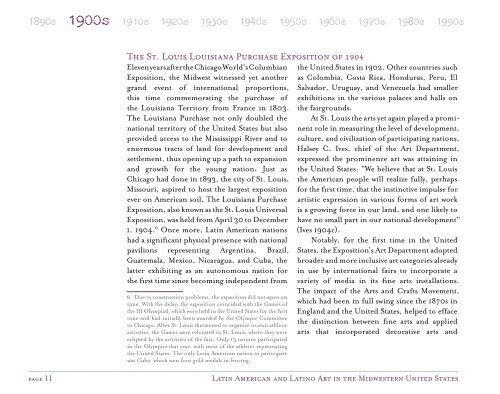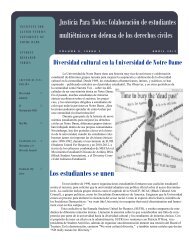Olga U. Herrera - The Institute for Latino Studies - University of Notre ...
Olga U. Herrera - The Institute for Latino Studies - University of Notre ...
Olga U. Herrera - The Institute for Latino Studies - University of Notre ...
You also want an ePaper? Increase the reach of your titles
YUMPU automatically turns print PDFs into web optimized ePapers that Google loves.
1890s 1900s 1910s 1920s 1930s 1940s 1950s 1960s 1970s 1980s 1990s<br />
<strong>The</strong> St. Louis Louisiana Purchase Exposition <strong>of</strong> 1904<br />
Eleven years after the Chicago World’s Columbian<br />
Exposition, the Midwest witnessed yet another<br />
grand event <strong>of</strong> international proportions,<br />
this time commemorating the purchase <strong>of</strong><br />
the Louisiana Territory from France in 1803.<br />
<strong>The</strong> Louisiana Purchase not only doubled the<br />
national territory <strong>of</strong> the United States but also<br />
provided access to the Mississippi River and to<br />
enormous tracts <strong>of</strong> land <strong>for</strong> development and<br />
settlement, thus opening up a path to expansion<br />
and growth <strong>for</strong> the young nation. Just as<br />
Chicago had done in 1893, the city <strong>of</strong> St. Louis,<br />
Missouri, aspired to host the largest exposition<br />
ever on American soil. <strong>The</strong> Louisiana Purchase<br />
Exposition, also known as the St. Louis Universal<br />
Exposition, was held from April 30 to December<br />
1, 1904. 6 Once more, Latin American nations<br />
had a significant physical presence with national<br />
pavilions representing Argentina, Brazil,<br />
Guatemala, Mexico, Nicaragua, and Cuba, the<br />
latter exhibiting as an autonomous nation <strong>for</strong><br />
the first time since becoming independent from<br />
6 Due to construction problems, the exposition did not open on<br />
time. With the delay, the exposition coincided with the Games <strong>of</strong><br />
the III Olympiad, which were held in the United States <strong>for</strong> the first<br />
time and had initially been awarded by the Olympic Committee<br />
to Chicago. After St. Louis threatened to organize its own athletic<br />
activities, the Games were relocated to St. Louis, where they were<br />
eclipsed by the activities <strong>of</strong> the fair. Only 13 nations participated<br />
in the Olympics that year, with most <strong>of</strong> the athletes representing<br />
the United States. <strong>The</strong> only Latin American nation to participate<br />
was Cuba, which won four gold medals in fencing.<br />
the United States in 1902. Other countries such<br />
as Colombia, Costa Rica, Honduras, Peru, El<br />
Salvador, Uruguay, and Venezuela had smaller<br />
exhibitions in the various palaces and halls on<br />
the fairgrounds.<br />
At St. Louis the arts yet again played a prominent<br />
role in measuring the level <strong>of</strong> develop ment,<br />
culture, and civilization <strong>of</strong> participating nations.<br />
Halsey C. Ives, chief <strong>of</strong> the Art Department,<br />
expressed the prominence art was attaining in<br />
the United States: “We believe that at St. Louis<br />
the American people will realize fully, perhaps<br />
<strong>for</strong> the first time, that the instinctive impulse <strong>for</strong><br />
artistic expression in various <strong>for</strong>ms <strong>of</strong> art work<br />
is a growing <strong>for</strong>ce in our land, and one likely to<br />
have no small part in our national development”<br />
(Ives 1904c).<br />
Notably, <strong>for</strong> the first time in the United<br />
States, the Exposition’s Art Department adopted<br />
broader and more inclusive art categories already<br />
in use by international fairs to incorporate a<br />
variety <strong>of</strong> media in its fine arts installations.<br />
<strong>The</strong> impact <strong>of</strong> the Arts and Crafts Movement,<br />
which had been in full swing since the 1870s in<br />
England and the United States, helped to efface<br />
the distinction between fine arts and applied<br />
arts that incorporated decorative arts and<br />
____________________________________________________________________________<br />
page 11 Latin American and <strong>Latino</strong> Art in the Midwestern United States



